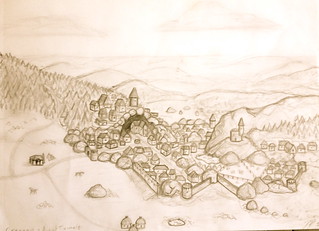Ethos

Some of the characters (including gods and goddesses) described on this site will have Alignments attributed to them. Some role-players are wary of these concepts. In part they feel that it needlessly restricts natural human behaviour. To some extent they think this because of the stupid caricatures that attach in popular culture to words like good and evil. Here I will try to rehabilitate good and evil and also redefine the five components of Alignment which combine to provide the many paths characters can choose to walk.
Good: In The Lands a person is good if (i) the emotions they feel most consistently and powerfully are deemed positive or constructive and (ii) the actions motivated by these emotions serve to help others. This they can do in any way they want and to any extent circumstances allow. The divine personages Olarin and Nitara are considered good.
Evil: In The Lands a person is evil if (i) the emotions they feel most consistently and powerfully are deemed negative or destructive and (ii) the actions motivated by these emotions serve to harm others. This they can do in any way they want and to any extent circumstances allow. The divine personages Urala and Kandoth are considered evil.
Lawful: The lawful person has an even-tempered disposition. In personal conduct they are methodical and calculating. They prefer living a life that is structured and will do what they can to make it that way. They tend to work best with others but can be frustratingly rigorous. The divine personages Bernali and Elchemar are considered lawful.
Chaotic: The chaotic person has a temperamental disposition. In personal conduct they are impulsive and spontaneous. They prefer living a life that is improvised and will do what they can to make it that way. They tend to work best alone but can enjoy rousing company. The divine personages Teloch and Linesa are considered chaotic.
Neutral: A neutral person represents a mix of all the characteristics listed in the other alignments. The mix is such that they rarely if ever behave in ways that would identify them with one of those other alignments. They tend to pragmatically do whatever necessity dictates however some of this alignment will actively strive to preserve a balance of such characteristics in the wider world. The divine personages The Deliverer, Garlomen and Marumi are considered neutral. Note that non-sentient life-forms are more correctly regarded as non-aligned than true netural.
One can imagine a two-axis chart and some classify the vertical 'good versus evil' as moral (focused on aims) and the horizontal 'law versus chaos' as ethical (focused on methods). However all this grows from personal dispositions and behaviours. It is understood that a distinct ethos begets more of itself - exposure to one sort of conduct to the exclusion of others results in the replication of that ethos in those so exposed.
These dispositions affect how a character responds to insult or injury in the long-term. If good they tend to offer and seek forgiveness. If evil they tend to desire vengeance. If neutral they tend to be satisfied by compensation. Alignment likewise affects how characters resolve conflicts. If lawful they prefer following formal codes and involving officers of state. If chaotic they prefer to negotiate informally with rivals one-to-one. If neutral they prefer drawing on a willing arbiter known to both sides.
With all this in mind one can now imagine Player Characters (PCs) of differing alignments co-existing and even forming friendships across opposing alignments. Issues will arise in these cases but such relations can still occur. Differences may only become marked in times of crisis. Finally whether 'good and evil' are the same as 'right and wrong' may depend on how adventures are interpreted.


<< Home